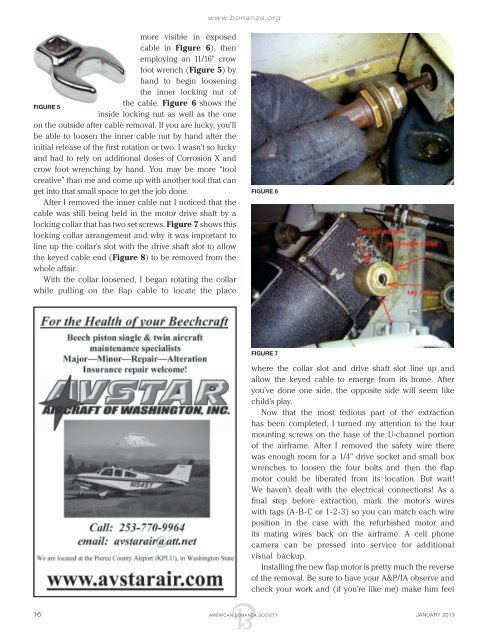Insurance Discount May Pay for Your BPPP Training - American ...
Insurance Discount May Pay for Your BPPP Training - American ...
Insurance Discount May Pay for Your BPPP Training - American ...
Create successful ePaper yourself
Turn your PDF publications into a flip-book with our unique Google optimized e-Paper software.
www.bonanza.org<br />
more visible in exposed<br />
cable in Figure 6), then<br />
employing an 11/16" crow<br />
foot wrench (Figure 5) by<br />
hand to begin loosening<br />
the inner locking nut of<br />
the cable. Figure 6 shows the<br />
Figure 5<br />
inside locking nut as well as the one<br />
on the outside after cable removal. If you are lucky, you’ll<br />
be able to loosen the inner cable nut by hand after the<br />
initial release of the first rotation or two. I wasn’t so lucky<br />
and had to rely on additional doses of Corrosion X and<br />
crow foot wrenching by hand. You may be more “tool<br />
creative” than me and come up with another tool that can<br />
get into that small space to get the job done.<br />
After I removed the inner cable nut I noticed that the<br />
cable was still being held in the motor drive shaft by a<br />
locking collar that has two set screws. Figure 7 shows this<br />
locking collar arrangement and why it was important to<br />
line up the collar’s slot with the drive shaft slot to allow<br />
the keyed cable end (Figure 8) to be removed from the<br />
whole affair.<br />
With the collar loosened, I began rotating the collar<br />
while pulling on the flap cable to locate the place<br />
Figure 6<br />
Figure 7<br />
where the collar slot and drive shaft slot line up and<br />
allow the keyed cable to emerge from its home. After<br />
you’ve done one side, the opposite side will seem like<br />
child’s play.<br />
Now that the most tedious part of the extraction<br />
has been completed, I turned my attention to the four<br />
mounting screws on the base of the U-channel portion<br />
of the airframe. After I removed the safety wire there<br />
was enough room <strong>for</strong> a 1/4" drive socket and small box<br />
wrenches to loosen the four bolts and then the flap<br />
motor could be liberated from its location. But wait!<br />
We haven’t dealt with the electrical connections! As a<br />
final step be<strong>for</strong>e extraction, mark the motor’s wires<br />
with tags (A - B - C or 1 - 2 - 3) so you can match each wire<br />
position in the case with the refurbished motor and<br />
its mating wires back on the airframe. A cell phone<br />
camera can be pressed into service <strong>for</strong> additional<br />
visual backup.<br />
Installing the new flap motor is pretty much the reverse<br />
of the removal. Be sure to have your A&P/IA observe and<br />
check your work and (if you’re like me) make him feel<br />
16 AMERICAN BONANZA SOCIETY JANUARY 2013

















